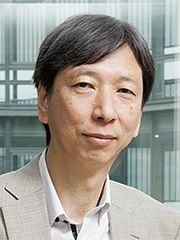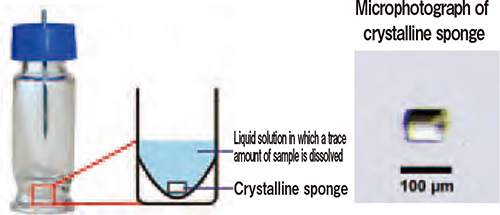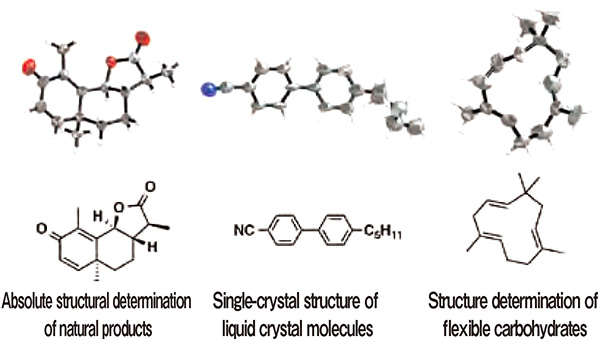Research Results
Molecular structure analysis without crystallization on the microgram scale
Crystalline sponge can solve the 100-year-old problem! FY2017

- Makoto Fujita (Professor, School of Engineering, The University of Tokyo)
- CREST
- Single Molecule and Atom Level Reactions "Self-organizing Molecular Systems Utilizing Transition Metals" Research Director (1997-2003)
- CREST
- Creation of Novel Nano-material/System Synthesized by Self-organization for Medical Use "Development of Self-organizing Molecular Systems for Chemical Translation of Biological Functions" Research Director (2002-2008)
- CREST
- Development of the foundation for nano-interface technology "Chemical study on self-assembly finite nano-interface" Research Director (2007-2013)
- ACCEL
- "Innovative Molecular Structure Analysis based on Self-Assembly Technology" Research Director (2014-2019)
The "100-year-old problem" was finally solved!
In a crystal of material, molecules are arranged three- dimensionally in order. An"X-ray crystal structure analysis"is an analysis method for determining molecular structure by using the diffraction of an X-ray deriving from that regularity (diffraction pattern). The representative one among the methods for determining molecular structure is the"single-crystal X-ray structure analysis" that uses single crystals (crystals with a constant crystal axis) as a sample. The molecular structure you can obtain through a diffraction figure is so clear that you might feel as if you were looking at molecules with your naked eyes. Therefore, as a means for providing accurate and reliable structural information, this method has been widely used in various fields, ranging from basic research to industrial circles.
However, this method is under a remarkable restriction in which target samples have to be crystallized beforehand. Therefore, the single-crystal X-ray structure analysis can neither be applied to liquid compounds that originally don't have a property to crystallize nor to samples that you cannot get enough of for crystallization. In March 2013, this problem, which had been even called the"100-year-old problem of X-ray crystal structure analysis,"was finally solved. The research group, led by Professor Makoto Fujita, a Research Director of CREST, succeeded in performing the single- crystal X-ray structure analysis without crystallization by simply soaking a sample into the material, called a crystalline sponge, in a solution containing from only a few micrograms (one microgram is equal to one millionth of a gram) of the target sample.
Simplified schematic of the crystalline sponge method

Dissolve a tiny amount of measurement sample in an appropriate solvent and pour the solution into a sample bottle containing a crystalline sponge. Allow the solvent to evaporate slowly, and the sample will become concentrated in the crystalline sponge. If you take the crystals out and conduct a normal X-ray crystal structure analysis on them, you will be able to observe the structure of the sample compound that has penetrated into the holes of the sponge as well as the framework of the sponge.
Analyzing structure with minimum amount without crystallization
A Crystal sponge consists of microporous complex crystalline material with countless holes (micropores) that have a diameter ranging from 0.5 to 1 nm (one nanometer is equal to one-billionth of a meter). The technique for storing molecules in pores has long been known; however, when a general microporous complex is used, guest molecules get packed into its holes randomly, from which you cannot obtain the periodicity that is needed for an X-ray crystal structure analysis. Therefore, by providing a microporous complex with the "molecular‒recognition faculty," which is the ability to stably capture guest molecules into an optimum positions according to the shape or properties of molecules, his research team succeeded in arranging captured molecules in a periodic sequence. This is the principle of a crystalline sponge. Thus, it becomes possible to conduct a single-crystal X-ray structure analysis without crystallizing liquid compound at room temperature.
Moreover, in this technique, you need only a 100 µm (micrometer; one µm is equal to one millionth of a meter) cube-sized single piece of crystalline sponge for one type of measurement sample. The maximum amount of molecules absorbed by this crystalline sponge is 5 µg and the minimum amount of molecules absorbed is only 80 ng (one nanogram; one ng is equal to one billionth of a gram). Surprisingly, the X-ray structure analysis makes it possible to determine the molecular structure with only such a small amount of sample.
Principle of crystalline sponge method

Pouring substrate into "crystallized space"
Breakthrough analysis technique "LC-SCD method"
Usually, many types of minor components extracted from plants and animals are separated and analyzed using a"liquid chromatography (LC)"method. When you use this method, you can isolate only less than a few micrograms of samples; therefore, it is extremely difficult to determine the molecular structure by means of the conventional technique.
With that, the research group has established an "LC-SCD (Liquid Chromatography- Single Crystal Diffraction)" method, a revolutionary analysis technique that directly connects the LC method and the crystalline sponge method. In this technique, a number of minor components isolated by means of the LC method are absorbed into the directly connected crystalline sponge, and then, the single-crystal X-ray structure analysis will be performed straightaway.
Meeting various needs, ranging from drug development to scientific crime investigation
As you might have noticed, the "crystalline sponge method" developed by the research group led by Professor Fujita is a technique that will exhibit a decisive power in the structural determination of minor compounds. Actually, the same group has already succeeded in determining the structure of more than one hundred types of minor components, including natural compounds and synthetic components.
But of course, that is only the beginning of what is to come. There are a lot of fields that call for the structural determination of minor compounds. For example, in the field of"drug development and process chemistry, "the structural determination for metabolic compounds, the structural determination for the high-throughput synthesis of large amounts of samples and the impurity structural determination for the new process development and quality control, etc. need to be performed, and also, in the field of study of food science, the impurity structural determination of seasonings, processed foods and raw materials, the structural determination of natural health food lead compounds need to be performed. Actually, the needs for structural determination are increasing more and more in various fields, including the study of flagrance materials and scientific crime investigation associated with agricultural chemicals, cosmetics, and organic compounds. And without a doubt, the crystal sponge method will meet those needs and make a significant contribution in many fields.
Structural analysis was performed on the following compounds by means of the crystalline sponge method.

